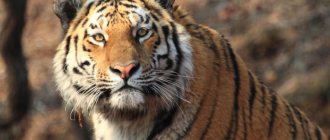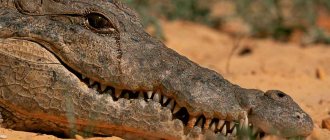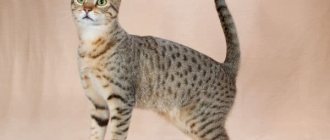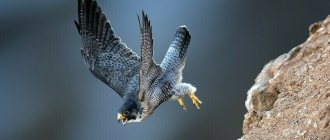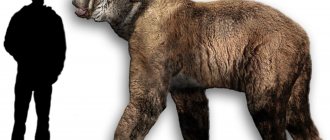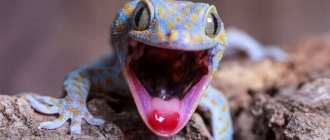Interesting representatives of the fauna world are beetles - representatives of the most numerous species of the Coleoptera order among the entire world of insects. They occupy 40% of all known invertebrate arthropods. The beetles are remarkable in that they live in all corners of the globe, they are not found only in the ice of the Arctic and Antarctica. Their Latin name translated means “wing” and “sheath,” as if describing the external rigidity of the beetle’s shell. The body morphology of all Coleoptera is the same: head, thorax and abdomen.
Many beetles have wings, but not all fly. Sometimes it is difficult for a beetle to rise into the air due to its large body weight, and they can live their entire lives on a tree or under a rotten stump. Of course, people feel the greatest delight when they encounter a beetle of enormous size or with an interesting shape of “horns.” There are not so many giant beetles in the world: the titanium woodcutter, the Hercules beetle, the large-toothed staghorn beetle, the Neptune beetle, the chirus beetle, the stag beetle, the relict woodcutter, the elephant beetle, and the goliath.
Lumberjack Titan
The titan woodcutter is the largest beetle in the world, distributed in Colombia, Ecuador, the Republic of Suriname, and the Amazon rainforest. The length of an adult insect often exceeds 15 cm. Entomologist from Germany Martin Jacobi caught the longest titan lumberjack on Earth (22 cm). Such a rare specimen did not fall into the hands of scientists, since Martin released the beetle into the wild. No arthropod of this breed has yet been found longer than this.
The Asian hornet is the largest representative of the Hymenoptera order. It lives in the Primorsky Territory, China, Laos and Thailand. The insect's body length is 5-6 cm, and its wingspan is from 7 cm.
Benefits and harms for humans
When the larva gets out, a hole is formed in the tree, from which small sawdust spills out. This way it becomes clear where this harmful beetle lives. Sometimes they eat the tree from the inside until it is completely rotten, and it collapses.
Some beetles, such as the house beetle, have become unpleasant neighbors for humans. They are rare in nature, but they thrive in wooden houses. The home's upholstery, floors, wood window frames, ceiling rafters and roof can all be damaged if this insect infests. They lay larvae that destroy anything wooden.
Even furniture, beds, tables and chairs, may suffer from such proximity. Beetles prudently lay eggs in hard-to-reach places - deep cracks in wooden products. After 2 weeks, larvae emerge from them, which begin their invisible destructive activities. If these items are not processed in time, after a while everything will turn into dust.
There are, however, individuals of the woodcutter beetle that are not dangerous, but, on the contrary, are beneficial. For example, the gray longhorned beetle is not so harmful to the forest. It only affects old and dying trees, which speeds up the transition of loose wood into humus. Many beetles act as pollinators of flowering plants, providing more benefits than classical pollinators.
Hercules beetle
The largest representative of the Dynastes genus on Earth. Scientists have discovered males whose length reaches 17 cm, and their wingspan exceeds 21 cm. The body length of females is slightly less - from 12 to 15 cm. A special feature of Hercules beetles are two curved horns - upper and lower. Insects use them to carry twigs, crush small fruits on which they feed, fight off enemies and fight with those who want to seize their territory.
The creature's jaws are so strong that with them it can bite through a small pebble or pierce the elytra of an opponent.
Beetles with horns and tusks
Stag beetle (Lucanus cervus)
If the jaws of predatory mammals and reptiles, no matter how powerful they are, at least fit in the mouth, then in arthropods everything is much more serious. And a striking example of this is stag beetles, especially their strong half - that is, the powerful males. Their jaws (mandibles) not only protrude forward, they are huge.
Their size is a third of the body of the beetle itself, the length of which is sometimes more than 9 cm. It is not without reason that such representatives of the insect kingdom are classified as members of the Rogachi family, where all have claws similar to horns. But stag beetles have the most prominent jaws (not just in any sense, but in the literal sense).
Their mandibles protruding forward with curly processes are shaped like the branches of almost real deer antlers. They are brown in color, but sometimes they are red, which looks terrifying. The claws appear to be filled with blood. But are they really that scary? As befits jaws, they are equipped with teeth, and therefore can be used for biting.
But giant insects are not able to cause serious harm. This applies to both humans and small living creatures. Stag beetles are not even predators; they feed on tree sap, and their offspring feed on rotten wood. Females with tiny horns are harmless. And males show aggression only towards each other.
In Russia, these beetles live over a vast European territory. But we can’t say that they occur en masse; rather, they come across them from time to time. And due to their rarity, they desperately need protection and protection. Although in local areas sometimes such stags take root in considerable numbers.
In addition to Europe, they are also common in Western and Western Asia. In addition, individual specimens have been found in North Africa. But despite their rarity, such creatures turned out to be very recognizable and famous, which was greatly facilitated by the unique appearance of the beetles .
Since ancient times, they have been mentioned in chronicles, myths, and various types of literature. Their dried horned heads served as amulets for the ancient Romans. And later they became accessories - additions to the costumes of some European nationalities. Largely due to such close attention, in particular from collectors, the population of these beetles has suffered greatly.
Hercules beetle (Dynastes hercules)
These are insects of the jungle of the American continent. They are members of the Dynastes genus, the male members of which are extremely horned. True, their advantages are not at all similar to the mandibles of stag beetles. The two horns are located one above the other and are serrated.
Hercules beetles are no exception among their family members. Their black, seemingly polished, shiny horns are longer than the body of the beetle itself (although the lower horn is smaller than the upper). Therefore, with a size of more than 17 cm, these heavyweight insects can scare many with their mere appearance.
However, they are especially aggressive mostly during the mating season and exclusively with their rivals. In fact, these giants can be offended by anyone: reptiles, animals, bats. These creatures are absolutely safe for humans.
Many hobbyists even keep them in their homes without fear. In nature, Hercules feed on rotten fruits, mainly overripe fruits, but also not the first fresh wood and vegetation. Like all beetles, they have wings with a span of up to 22 cm. When flying, they make a noisy hum.
Dynastes neptunis (Dynastes neptunus)
This beetle from South America never received an official Russian name. Therefore, it would be more correct to call him, translated from Latin, “Neptune from the Dynastes family.” Although, probably, such inattention was shown to him in vain.
This giant is no worse than its large relatives, moreover, it is an absolutely remarkable creature. After all, it has as many as four horns: two short straight ones growing in the middle; as well as two external ones - huge, curved with jagged edges.
Neptune is a brother of Hercules by birth and family. True, judging by the size, the youngest. Although, if we compare the largest males with a size of up to 15 cm, the difference may be insignificant. And the lifestyle and taste preferences of these two beetles agree in many ways. Neptunes are often kept in terrariums. They are quite docile, but the bully males start fights among themselves.
Large-toothed staghorn (Macrodontia cervicornis)
Although this species is classified by entomologists as a member of the Longhorned family, its representatives are more similar to staghorns. First of all, because their mustaches are not very long. But the mandibles (that is, the upper jaws with serrations) are just impressive. They are very convenient for turning tree bark, which such beetles feed on, into powder.
This is why these devices are given by nature. In addition, giants eat leaves, pine needles, and pollen. And the larvae, which in due time become beetles through an almost magical transformation, feed with great appetite on rotten wood, living and growing in it for 6 long years.
But unlike some members of their family, these beetles are not considered pests. On the contrary, they benefit the forests of South America where they live, clearing them of unnecessary rot and spreading pollen of useful plants everywhere.
These insects and their fatty larvae feed on a considerable number of reptiles, animals and birds. But, unfortunately, this and much more contributed to the catastrophic reduction in the number of such large (up to 17 cm long) beetles. And their malicious enemies should again include the same collectors who pay exorbitant prices for wonderful specimens for their collections.
Atlas beetle (Chalcosoma atlas)
Giants from the world of insects are often given names associated with the names of various legendary characters: Hercules, Titan, Goliath. The types of beetles in the photo can show how true their nicknames are.
Our next hero, a resident of the southeastern regions and islands of Asia, was nicknamed Atlas in honor of the great strongman capable of holding the firmament, familiar to us from the myths of Ancient Greece. Male representatives of this species, the largest of which are 11 cm or more in length, are distinguished by a metallic dark color.
They have as many as three bizarre outgrowths. The upper two, curved like a crescent and protruding forward from the front of the back, look like long smooth horns. And the middle bottom one resembles a knot bent upward, placed instead of a nose.
Chalcosoma caucasus
Representatives of this species have a maximum length of 13 cm. But purely in appearance they are in many ways reminiscent of atlas beetles, although noticeably larger than them. And males are decorated with similar bizarre outgrowths. And this is not surprising, because these two species belong to the same genus Chalcosoma. By the way, we note that all its members are impressive in size.
The larvae of this species grow among fallen old branches and in rotten wood. They also find refuge in rotten stumps, where there is enough nutritious material for their development. The diet of adults consists of vegetation and fruits.
It is quite easy to distinguish females from males. First of all, females are hornless. And then, in contrast to the black with a greenish tint, shiny and smooth vestment of males, they have matte dark tuberculate surfaces dotted with brown hairs.
Elephant beetle (Megasoma elephas)
The uniqueness of this beetle, which belongs to the Rhinoceros subfamily, is expressed in the presence of outgrowths similar to an elephant's trunk and tusks, and therefore this nickname was assigned to it. Elephant beetles are found mostly in the jungles of America, but also in some places in Australia.
For all three months of their adult life, they are on a fruit diet, which includes bananas, pineapples, tangerines and other goodies. And they wash it all down with tree sap. During the day they sleep among the branches and leaves, and at night they feast on them.
Males, which are much larger than females and grow up to 12 cm, from time to time start serious fights with each other, using their longest horn. This is their routine and entertainment. Before this, they live as larvae in rotten trees and stumps for a couple of years.
Neptune beetle
Dynastes neptunus is a close relative of the Hercules beetle, found in Brazil, Ecuador, Panama and other South American countries. It is named after the ancient Roman mythical deity - Neptune, god of the seas, as its 3 horns of different sizes resemble a trident. The maximum length of Dynastes neptunus recorded by scientists is 15 cm. The usual sizes of representatives of this species rarely exceed 8 cm. The life expectancy of the beetle in the adult stage is up to 7 months.
Bigtooth staghorn
Large-toothed staghorns inhabit the territory of the South American continent and prefer to settle in tropical rainforests or mangroves. They are distinguished by their enormous size and powerful jaws, designed for plucking leaves, berries, digging the soil and protecting them from natural enemies. The largest beetle was caught in the province of Satipo (Peru) in 2010. Its length is almost 17 cm. The preserved copy was sold to a private collector for $1,500, who subsequently resold it abroad for three times as much.
Habitats and food
Insects live in earthen burrows, into which they drag their green food and compact it.
Under the influence of bacteria, the vegetation brought into the burrows begins to rot, turning into silage. This mass is the main food for beetles. The powerful jaws of insects allow them to cut leaves, shoots, inflorescences and even young grapevines. Snow beetles differ from other beetles in that they do not feed on excrement.
They pose a great danger to agricultural plants. In one day, one insect can destroy up to 10 grapevine shoots.
Longhorned chirus
Xixuthrus heros is endemic to the Republic of Fiji. For many years it was considered extinct until scientists discovered several adult specimens in 2013. The chirus beetle is a large creature with strong elytra and long antennae. The average body length of a male is 17 cm, females are up to 15 cm. Insects feed on plant foods and occasionally eat small midges. They have a hard time withstanding climate change and in captivity in most cases die. Xixuthrus heros is listed in the Red Book as an endangered species.
The best chemicals
Insecticides are used to control insect pests. The best time to treat the soil with them is during the flowering period of apple trees. For the most part, chemicals are not able to completely destroy snowbirds. They hide in their burrows and wait out the processing time. To achieve a positive effect, the soil is treated during insect breeding.
Along with soil cultivation, plant foliage can be sprayed with chemical solutions. Insects escaping from the effects of the drugs are collected by hand and burned. When preparing solutions, it is important to strictly follow the dosage recommended by the manufacturers.
"Decis"
The drug has a universal effect. It is a pesticide and is widely used in agriculture to treat grain crops and melon crops. In summer cottages I use it to destroy various insect pests that eat garden plants, flower beds and harm garden trees and shrubs.
Decis is often used as a preventative plant protection product. The product effectively kills not only beetles, but also flies, cockroaches, bedbugs, wasps, moths and fleas. The pesticide is completely useless for fighting ticks and mosquitoes.
The main component of the drug is deltamethrin. This is an analogue of a natural substance found in plants of the Pyrethrum family. "Decis" is produced in the form of 2.5% and 12.5% emulsion, as well as in the form of 25% Profi granules.
The emulsion is bottled in 0.6 mg bottles and ampoules of 2 ml, granules are packaged in 1 g bags. For large farms, manufacturers bottle ready-to-use solutions of the drug into 5 liter canisters.
"Decis" refers to drugs with contact-intestinal action. Once inside the insect, it removes and destroys nerve fibers. Insects lose the ability to move, feed and die within 5 minutes.
After treatment, the drug retains its properties on plants for another 2 weeks. It is resistant to rainfall.
Advantages:
- efficiency;
- speed and long-term action;
- adaptation for all climatic zones;
- lack of phytotoxicity;
- does not accumulate in the soil;
- safe for earthworms;
- does not penetrate into plant fruits.
Flaws:
- toxicity;
- partially loses properties at t +27°C;
- cannot be used near ponds and apiaries.
"Decis" is not addictive, so it can be used repeatedly. When working with the drug, it is imperative to observe safety precautions.
"Arrivo"
The drug is used to destroy adult beetles, their larvae and eggs. The main component of the product is cypermethrin. It has a depressing effect on crawling and flying insect pests.
The product is produced in the form of an emulsion, packaged in 1.5 ml ampoules. “Arrivo” is used not only to combat crabweed, but also to kill flies, cockroaches and fleas.
When eating plants treated with the drug, the poison penetrates the insects, causing paralysis of their nervous system and death. Arrivo has an active effect on plants for 20 days after treatment. After this period, it is recommended to re-treat the plants.
Advantages:
- efficiency;
- ease of use;
- resistance to adverse weather and temperature changes;
- speed and long-term action.
Flaws:
- cannot be used to treat areas near ponds and apiaries;
- When working with the drug, precautions must be taken.
Arrivo solution is used to treat soil and plants. It is prepared from a bucket of water and 1 ampoule of the product. The solution is sprayed onto the plants using a spray bottle.
When treating areas for beetles, maximum attention is paid to garbage heaps.
The consumption rate of the solution per 1 sq.m depends on the type of plant. For example, for grapes it is 200 ml, for fruit trees - 380 ml, potatoes - 160 ml, melons - 320 ml.
"Karate"
Powerful insecticide with universal action. Used to destroy insect pests of agricultural crops at any stage of their development.
The main component of the drug is lambda-cyhalothrin. Manufacturers produce the drug in the form of an emulsion, packaged in ampoules.
To treat plants, “Karate” is diluted with water. The dosage of the drug is indicated on its packaging. "Karate" has a delayed effect. It begins to act 2-3 hours after treating the plants.
In people suffering from allergies, “Karate” can provoke an attack.
Advantages:
- high efficiency;
- does not kill earthworms;
- resistance to rainfall and solar radiation;
- can be used as a preventive plant protection product.
Flaws:
- negative impact on the fauna of the ecosystem;
- When working with the drug, precautions must be taken;
- Do not treat areas near water bodies.
Relic Lumberjack
The relic woodcutter can also be called the Ussuri relic barbel. This is the largest representative of beetles living in Russia and the CIS countries. The majority of relict woodcutters are in the mixed and broad-leaved forests of the Ussuri Nature Reserve. The body length of an adult arthropod is 11 cm. Over the past 10 years, the population of the species has declined sharply. The reason for this was active deforestation and the catching of mature individuals for collection.
Where does the woodcutter beetle live?
Photo: Relic woodcutter beetle
The longhorned beetle can thrive almost anywhere there is wood. The only exception is regions with too low temperatures. The favorite tree species of such insects are conifers. However, they also live in other trees, shrubs and even herbaceous plants. Sometimes insects choose country houses and dachas to live. They can feed on wooden furniture and building elements, which causes great harm.
The largest representative of the family, the titanium beetle lives in Colombia, Peru, Ecuador, and Venezuela. They settle in the Amazon River basin. Residents of these countries sometimes independently attract such insects to their homes, then sell them for huge sums. The demand for titan beetles is very high among collectors.
In European countries, Iran, Turkey, Western Asia, the Caucasus and the Urals, woodcutter beetles live in large populations. They also live in Moscow. Animals choose deciduous, mixed forests to live. They settle in dead trees. In general, about five hundred species of longhorned beetles live in Russia. Other species of the woodcutter beetle are present on almost all continents. They live in Poland, Belarus, Ukraine, and Moldova.
Dynastes grantii
One of the largest beetles in the world, its length exceeds 8.5 cm. Males have two huge horns with teeth and hairs on the inside. They inhabit northern Mexico, Chihuahua, Arizona, New Mexico and Utah. Dynastes grantii eats fermented fruit juice, hard bark, and rotting vegetables and fruits. Insects do not climb trees; they prefer to look for food on the surface of the soil.
Stag beetle
A large beetle from the genus Lucanus, inhabiting the broad-leaved forests of Europe, Central Asia, Turkey and Iran. Rarely found in the arid regions of North Africa. Males have strong mandibles that look like huge horns. In females they are practically invisible. The body length of the beetle is up to 9 cm. Insects are characterized by a diurnal lifestyle. They make short flights in search of food and are not known for their endurance. Tired, the stag beetle lands on a tree or simply falls to the ground, where it is often discovered by passers-by.
The stag beetle received the title of “insect of 2012” in three countries at once - Germany, Austria and Switzerland.
How to get rid of barbel
The longhorned beetle at home is one of the most terrible enemies of man, if not the most dangerous. Its larvae are hardy, voracious, and are not immediately detected. Therefore, you need to know some rules on how to get rid of the longhorned beetle so as not to be left homeless.
- When choosing wood, be sure to check whether it has been treated with an antiseptic.
- When constructing a building, use special finishing products for wood with an antiseptic. They will prevent bugs from invading.
- If you have bugs, be sure to carry out emergency treatment with chemicals. These are bromomethyl, zinc chloride, sublimate. Moreover, such treatment must be carried out 2-3 times a year. The larvae are tenacious, and prevention is a must. It is important to remember that the process must be carried out under the control of the relevant services. It is better to call specialists from the sanitary and epidemiological station for this purpose.
You should also contact specialists if you decide to fumigate against beetles, treat with poisonous gas, or install poisonous baits. All these methods require a careful professional approach.
You can treat it with dry steam or, conversely, by freezing. Only these methods are difficult to implement at home. And they are not safe. Therefore, they are used in production, and only in strictly designated places.
A modern method of getting rid of house beetles is microwave irradiation. A special device heats the wood even in hard-to-reach places, destroying the larvae. The advantage of this method is safety for people and buildings. It happens that some affected parts are easier to cut out and replace with new, undamaged and treated ones.
Burrowing cockroach
Another name for the burrowing cockroach is the rhinoceros cockroach. Unlike other insects of this species, arthropods are not pests and perform an important function in the ecosystem, namely, they destroy fallen leaves and rotting particles of vegetation. A burrowing cockroach cannot be called aggressive. Under normal conditions, it does not bite and sits calmly in a person’s palm. However, if you press him down, he will squirm and possibly pinch painfully with his jaws. The length of an adult insect is 8-10 cm.
Lucanus capreolus
A huge insect, a close relative of the stag beetle. Found in deciduous forests and urban parks in South Carolina, Alabama, Ontario, Nebraska, Oklahoma and Illinois. Its name is translated from Latin as “little goat.” In biological nomenclature it is called the European roe deer. Males have pronounced sexual dimorphism. They have large mandibles and strong paws. Lucanus capreolus beetles are nocturnal and feed mainly on tree sap. The body length of an adult is up to 6 cm.
elephant beetle
Megasoma elephas is found in Central America, Australia, Mexico and parts of Africa. They are endowed with the ability to independently regulate their body temperature, thanks to which they are not afraid of sudden climate changes. The length of males is 12 centimeters, females are smaller - from 6 to 8 cm. The elephant beetle is predominantly nocturnal. All day long, insects hide among the foliage, and at nightfall they go in search of food. They eat cherries, citrus peels, tree sap, overripe pineapples and bananas.
The heaviest beetle in the world
Goliath beetle The
Goliath beetle continues the list, which also has the title of one of the heaviest beetles in the world. Its height reaches twelve centimeters, while its weight can be 80-100 grams. Habitat: Central and South-Eastern Africa. An adult beetle lives for about six months. At the same time, it actively feeds on ripened fruits and the sap of some trees.
Goliath beetle wings
Goliath larvae, living underground, eat humus and fallen tree leaves. The color of the beetle is black and white with patterns that vary depending on the subspecies of the insect. A special feature of these beetles is that during flight, the elytra do not open. When the wings open, they remain folded on the back. But this does not affect the quality of flight in any way, due to the special hollows located on the back of the beetle.
Giant water bug
A predatory insect inhabiting the territory of India, Thailand and South America. Giant water bugs are most common in Florida, where locals call them “alligator ticks.” The peculiarity of the beetle is its disgusting appearance. They carry offspring on their backs and cause panic attacks in trypophobes. The diet of giant water bugs includes fish eggs, larvae and small insects, small fish and even frogs. The arthropod has strong jaws, with which it holds prey until it dies from the poison injected into it.
The giant weta is a huge wingless insect whose body is covered with dense scales. Externally, the arthropod resembles a thick brown grasshopper. The length of its body ranges from 7-9 cm.
Giants of the insect world
Belostoma (Belostomatidae)
Now let's look at other, no less interesting, but not so harmless creatures. True, in the strict sense they are only half beetles, since they belong to the order Hemiptera. They're just water bugs. But who would have thought that they could be so huge!
There are a total of 170 species in this family. To be honest, there are varieties whose representatives are not particularly impressive in size. But among them there are also giants, reaching a length of 17 cm. We will talk about these in more detail.
They live mainly in the tropics of Asia, but are also found here and there in Australia and the American continent. Nature has done a lot to ensure that these creatures, despite their size, are invisible.
Their body is very flat, and in shape and color it looks like a fallen leaf. Moreover, the shade of colors varies to match the aquatic environment where these wonderful insects live, hiding among the rapidly growing algae. But the main thing is the front legs of such bugs, equipped with predatory tenacious hooks.
With them they catch not only aquatic life, frogs and fish, but even small turtles, which they eat in the most sadistic way for their sweet souls. This is where their scary proboscis comes into play. They give them a lethal injection by injecting saliva with dissolving enzymes into the victim’s body.
And then they calmly suck in a homogeneous nutritious liquid - all that is left of the poor animal. Such creatures, of course, do not deliberately attack humans; they prefer to deceive people by pretending to be dead. But if this number doesn’t work, they are quite capable of biting (or rather pricking).
Such an attack is not life-threatening, but the victim experiences extremely painful sensations. However, people themselves will eat anyone. That’s why they also feed on such predatory bugs in some places. For example, in Thailand, whitefish is eaten with great appetite fried with seasonings and in sauce.
Walking branch (Phobaeticus serratipes)
Ghosts are not just restless spirits wandering in the dark of night. This is the name given to the rank of herbivorous insects. These animals are also nicknamed “phantom horrors.” Most of them are inhabitants of the jungles of Asia. They are large in size and look similar to various parts of plants.
One of the representatives of this rank is the Malayan giant stick insect. If measurements are taken with extended limbs, the length of these insects will be more than half a meter (although the males are noticeably shorter). These creatures are nicknamed “walking branches,” which exactly describes their habits and appearance. They can be green or light brown in color.
Holding the branches of plants with their paws, stick insects visually completely merge with them into a single whole, thereby becoming completely invisible to unwanted eyes. But if you disturb them, they run away, often shocking the offender.
If you get creative and grab them by the limbs, the insects throw them away, eventually growing new ones, in whole or in part. Such animals reproduce not only in the traditional way. After all, if necessary, females can raise new generations of “walking branches” even without fertilization.
Gromphadorhina portentosa
Behind the intricate Latin name, in essence, lies an ordinary cockroach, that is, a representative of the Tarakanov order. Although, how ordinary is he? This is another giant with dimensions up to 10 cm. In natural conditions, such cute monsters are found, whose body is made up of many brown segments with black and yellow connections, exclusively on the island of Madagascar.
But they don’t play pranks in people’s homes; they prefer to live freely in nature. They settle on woody vegetation of various sizes, feeding on its parts and fruits; sometimes on the ground among rotting leaves. Although exotic lovers keep some individuals as pets. In well-fed and carefree captivity, these wonderful insects live for a long time - about 5 years, delighting their owners.
A distinctive feature and a very important element of males is their antennae, which capture the smells of their friends. These are objects of male pride, as well as the envy of rivals who, in a fierce struggle for reproduction, try to bite them off to their competitors. During courtship and fights, males emit hissing whistles. Similar impressive signals are used by such cockroaches to scare away predators in anticipation of danger.
New Zealand giant weta (Deinacrida heteracantha)
In the area where they are found, that is, on Little Barrier Island, these creatures were called “deities of freaks” by the aborigines. And this, frankly speaking, says something. Perhaps that is why these creatures leave their shelters on dark nights. Not only nature, but also scientists slightly offended these insects by classifying them as Orthoptera, despite the fact that they do not have any wings.
But the size and weight of our awkward creatures cannot be called small, and their length in some cases reaches 10 cm. Moreover, their paws are powerful and covered with spikes. And this weapon pierces the bodies of many enemies - both predators and arthropod relatives. By the way, the latter often become food.
In addition to animal foods, the diet also includes plant foods. By consuming it, they at the same time spread the seeds of useful plants, which benefits the environment. The areas where such insects take root can be very diverse. After all, adapted wetes feel great both in trees and in rocky caves.
Chalcosoma atlas
A large beetle from the lamellar beetle family, the body length of which varies between 8-11 cm. Females are characterized by the presence of two large horns on the prespinum, used for protection and digging the soil. Males have an additional horn. Insects use it to fight rivals during the mating period and defend themselves against natural enemies. Chalcosoma atlas inhabit the territory of Southeast Asia and Malaysia. The name of the beetles comes from the name of the mighty titan from ancient Greek mythology - Atlas.
Dung beetle
The huge black insect lives in the Far East, the Kuril Islands, China, Korea, Japan and the Caucasus. The body length of an adult reaches 4 cm. Dung beetles and thorn-bearing dung beetles are listed in the Red Book as an endangered species and are protected by environmental organizations. Their feature was a wide chest, primitive mouthparts and short antennae. Meanwhile, insects have strong paws, with which they dig the ground in search of food and roll earthen balls.
Control measures
It is difficult to clear the area of snowflakes. You need to start fighting it immediately at the first signs of insects appearing in the garden or vegetable garden. The fight against them is complex.
Agrotechnical works
This type of insect control is used simultaneously with insecticidal treatment or the use of folk remedies. This is the only way to cope with the problem that has arisen. Agrotechnical work includes digging or plowing a summer cottage. The depth of digging the soil should be at least 30 cm. Work is carried out in the fall. In the spring, the soil on the site must be loosened.
These measures help destroy the insect burrows that they build in the ground. As a result, both adults and larvae die. An equally common method of control is mechanical collection and destruction of beetles. They are collected early in the morning. The process is labor-intensive, but also effective. Since insects do not have wings, you can enclose the area with a solid, buried fence.
Expert opinion
Mityuk Stefania Bogdanovna
Very often, summer residents use sunflower oil to control pests. They fill insect holes with it. It blocks the entrance of insects into the burrows and blocks the respiratory functions of the swifts. After filling the holes with oil, the beetles crawl out and die. Instead of sunflower oil, you can use polyurethane foam.
Chemical control methods
Pest control with this method involves the use of insecticides and special traps. The latter are arranged in grooves that are arranged along the perimeter of the site. Dig them to a depth of 25-30 cm. Grass, previously soaked in an insecticide solution, is placed at the bottom of the groove. The beetles will definitely gather in these grooves and receive their lethal dose of poison.
Traditional methods
The most popular folk methods of pest control include treating the soil with a solution of laundry soap or boiling water. They fill beetle holes. They carry out work early in the morning, while the snowbirds have not yet crawled out to the surface. Such methods are environmentally friendly. Processing needs to be done several times.
There are many passages in beetle holes where they can hide when filled with soapy water or boiling water. Traditional methods of controlling insect pests are used from April to June while the larvae have not yet turned into beetles.
The following are used as preventive measures to protect against kravchik:
- fencing grape shoots, tomato seedlings, eggplant and peppers with plastic bottles or aluminum cans;
- strawberry beds and flower beds are fenced with borders made of slate, metal sheets or boards;
- beet, garlic and onion beds are raised to a height of 10-15 cm and their walls are made steep;
- seedlings are planted in beds in plastic cups with a cut out bottom.
Have you ever had to fight snow beetles?
Was the caseNever
